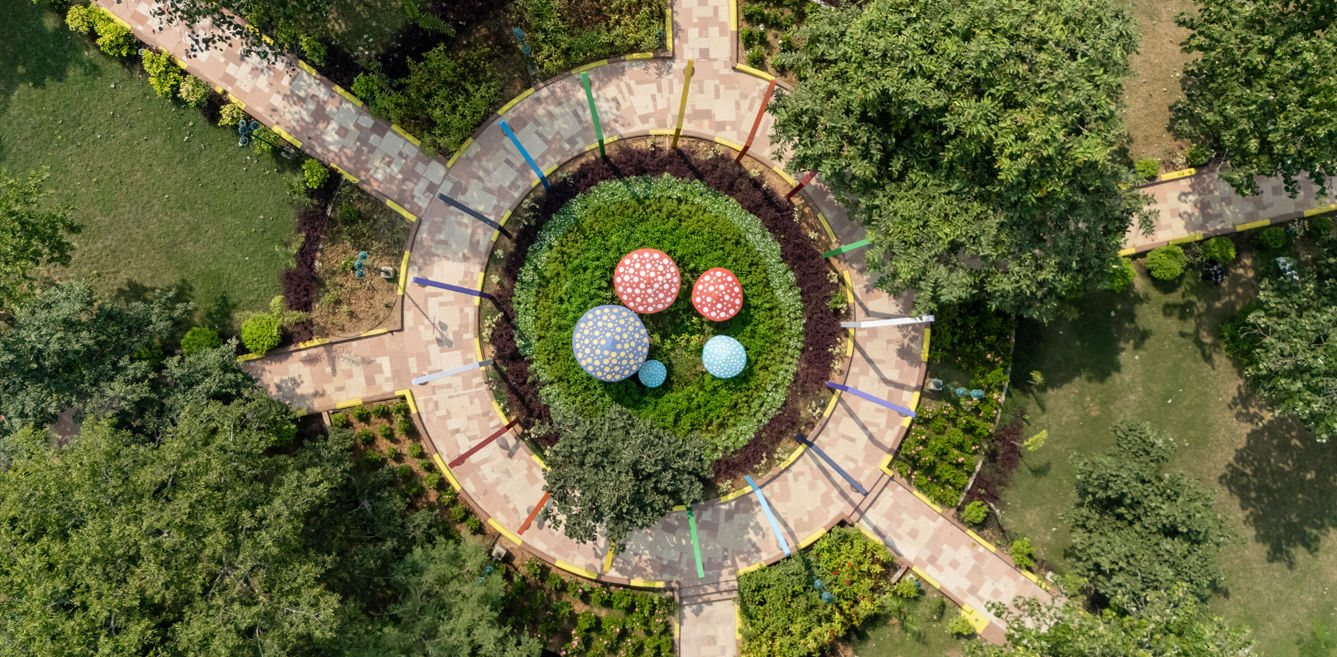

Tucked amidst the serene landscape of Bihar’s Kaimur district, the Maa Mundeshwari Wildlife Eco Park shines as a symbol of sustainable design and cultural preservation. Conceptualised and designed by architect Angad Singh Phokela of Rurban Design Lab (Iconographic Designs Pvt. Ltd.), this 14-acre eco-park is an extraordinary example of architecture that harmonises with nature while celebrating heritage and community engagement.
A Grand Entrance to Nature’s Retreat
A grand rocky arch, adorned with sculptures of native wildlife and intricate tree motifs, welcomes visitors into this eco-conscious sanctuary. The secondary gate, featuring vintage green lamp posts and wood grain patterns, further reinforces the park’s commitment to blending natural elements with architectural design.
Landscaping that Respects and Revives Nature
The park’s trails trace the gentle undulations of the Kaimur hills, ensuring that the existing topography remains undisturbed. Native trees and plant species are strategically integrated, fostering biodiversity while maintaining the land’s ecological balance. Automated irrigation systems further contribute to the park’s sustainability, reinforcing its commitment to water conservation.
Art Meets Ecology
One of the park’s most striking installations, the Animal Parade, features life-sized sculptures of rhinoceroses, lions, giraffes, and even a dinosaur playfully perched on a long cycle. This dynamic artistic display captivates children and adults alike while subtly educating visitors about wildlife conservation.
As visitors walk under the vibrant Rainbow Pergolas, they are enveloped in a spectrum of colours symbolising unity and diversity—an artistic and philosophical representation of nature’s inclusive spirit.
The Bamboo and Metal Foot Over Bridge
Another architectural highlight of the park is the Bamboo and Metal Foot Over Bridge, a structure that merges traditional craftsmanship with modern engineering. Utilising bamboo’s tensile strength and metal’s durability, the bridge eschews industrial fasteners in favour of traditional rope bindings, reinforcing the park’s ethos of sustainability.
Water, Emotion, and Spiritual Connection
At the heart of the park lies the Buddha Sarovar, a tranquil water body that restores the area’s natural hydrology while providing a cooling microclimate. Artificial waterfalls and restored ponds enhance both the aesthetic and ecological value of the space.
The Trees of Emotion installation is another immersive feature, with nine intricately carved sculptures representing the Navarasa—the nine fundamental emotions in Indian art. These artistic elements interact with living trees, offering visitors a contemplative dialogue between culture and nature.
Cultural and Artistic Touches
Drawing inspiration from the Maa Mundeshwari Temple, India’s oldest living temple, the park’s sculptural elements and motifs pay homage to the region’s spiritual heritage. These artistic flourishes bridge the past and present, reinforcing the deep connection between culture and the environment.
An Amphitheater Rooted in Nature
At the center of the park lies an open-air amphitheater, designed to host cultural performances, educational programs, and community gatherings. Built with locally sourced stone and boulders, this 300-400-seat venue integrates seamlessly with the natural surroundings, using vegetation as a natural sound buffer for enhanced acoustics.
Eco-Friendly Infrastructure
From rainwater harvesting systems to solar-powered lighting, the park embodies an unwavering commitment to sustainability. Locally sourced bamboo, stone, and wood ensure minimal carbon footprint, while the park’s energy-efficient design integrates renewable energy sources and low-impact construction techniques.
Solar-powered irrigation and lighting systems significantly reduce reliance on non-renewable energy, while waste management initiatives, including composting and segregated waste disposal, further reinforce the park’s eco-conscious approach. Additionally, native plant landscaping enhances biodiversity and helps maintain ecological equilibrium, ensuring that the park remains a thriving natural habitat.
Blending Context, Sustainability, and Community Engagement
The vision for Maa Mundeshwari Wildlife Eco Park stemmed from the Department of Environment, Forest, and Climate Change’s goal of creating an eco-tourism hub that respected both the area’s spiritual sanctity and ecological significance. The design team at Rurban Design Lab approached this challenge by prioritising minimal permanent interventions, reducing the use of concrete, and preserving the natural terrain while actively working to lower the project’s overall carbon footprint. By incorporating traditional materials, vernacular construction techniques, and community involvement, the park serves as a living testament to the harmonious coexistence of modern sustainability and ancient wisdom.
Challenges and Solutions
One of the primary challenges faced during the project was the integration of contemporary structural requirements with traditional craftsmanship. The park’s commitment to sustainability meant replacing industrial fasteners with handcrafted rope bindings—a meticulous process that required collaboration with local artisans and engineers. Additionally, the fluctuating terrain of the Kaimur hills necessitated adaptive planning to ensure minimal disruption to the existing landscape.
Through extensive research, iterative prototyping, and site-sensitive design strategies, these challenges were transformed into opportunities, resulting in a park that feels both deeply rooted in its context and forward-thinking in its execution.
A Model for Eco-Tourism in India
The Maa Mundeshwari Wildlife Eco Park is a living, breathing ecosystem that exemplifies how thoughtful architecture can elevate conservation efforts while fostering cultural and community engagement.
The park demonstrates that with careful planning and innovative design, it’s possible to create spaces that not only preserve our natural heritage but also enrich it through thoughtful human interaction. As India continues to develop its eco-tourism infrastructure, the Maa Mundeshwari Wildlife Eco Park serves as an inspiring example of architecture that truly serves both people and planet.
FACT FILE:
Name of the project: Maa Mundeshwari Wildlife Eco Park
Firm Name: Rurban Design Lab(Iconographic Designs Pvt Ltd )
Design Team and Designation: Ar. Angad Singh Phokela ( Principal Architect )
Website: www.rurbandesignlab.in
Location of the project: Bihar, India
Area (Sq.ft): 14 Acre
Photo courtesy: Rurban Design Lab
The art world is having a moment. From the packed gallery weekends in Mumbai to…
“Hair is everything. We wish it wasn’t, so we could actually think about something else…
For most people, Coachella is about the music. Or the outfits. Or seeing someone faint…
In the middle of Mumbai's bustling cityscape, Sakura Home emerges as a contrast to chaos.…
“The 24-foot wall of Tree of Life Chintz artwork in the double-height living area is…
Homes are increasingly becoming reflections of the people who inhabit them. Conceptualised and designed by…